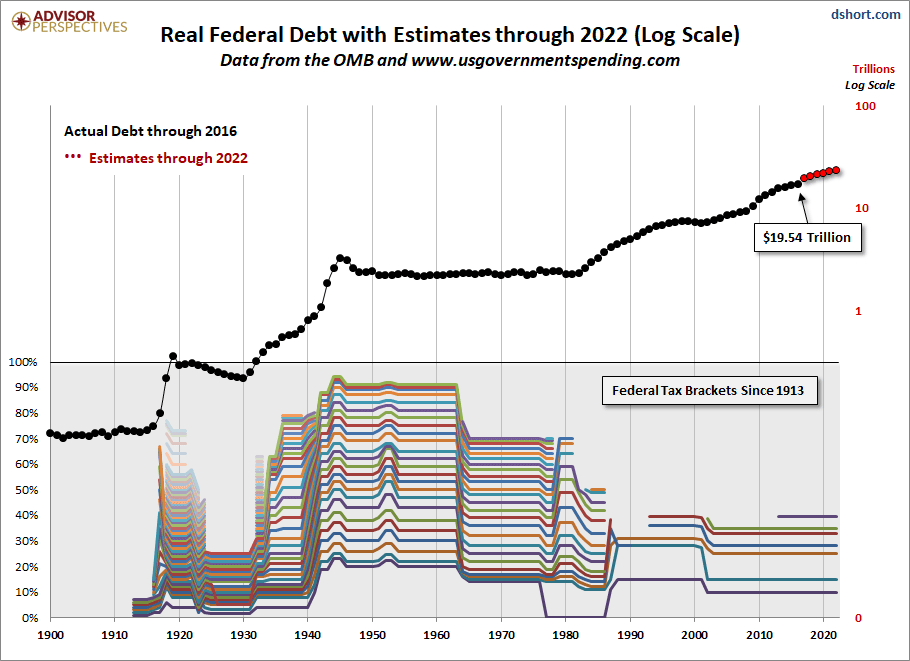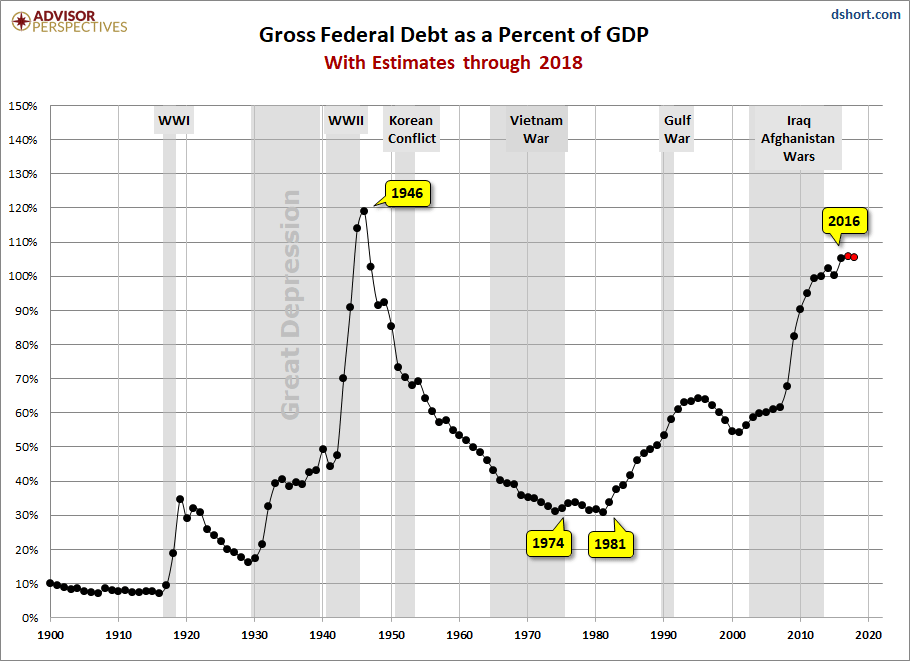With the Republican tax bill looming, we've updated this article to include the latest figures and estimates for federal debt and taxes.
Federal debt is defined as "the gross outstanding debt issued by the United States Department of Treasury since 1790" according to https://www.usgovernmentspending.com. It does not include state and local debt, agency debt, nor entitlement programs such as Medicare and Social Security. It does include debt held by the public, debt held in government accounts, and by the Federal Reserve Board. Current federal debt per person is $62,814.
You may also like Yolanda York on Applying For Social Security and Medicare
The first chart is a snapshot of federal debt with government forecasts through 2022 with an overlay of tax brackets since the onset of annual federal taxation in 1913.
As the chart clearly illustrates, the tax cuts in the early 1980s coincided with the beginning of an acceleration in real federal debt from a relatively consistent level over the previous three decades.
The next chart replaces real debt with the debt-to-GDP (Gross Domestic Product) ratio, which gives us a better idea of the true debt burden. Against the backdrop of US history, the contours of the first two-thirds of the chart are easy to understand. Debt-to-GDP soared with the US entry into World War I, as did the personal tax rates. After the war, the ratio gradually dropped, this time against the backdrop of the "Roaring Twenties." The Crash of 1929 and Great Depression triggered a rise in the ratio to levels exceeding the peak in World War I. Logically enough, World War II brought about another rapid rise in Debt-to-GDP. War costs drove the ratio to a peak near 120% in 1946.
The ratio rapidly declined after WW II and began a bottoming process 28 years later in 1974, where it hovered in a 3% range until it began increasing in 1982. Then, over a 14-year period, the ratio more than doubled from 30.8% in 1981 to 64.5% in 1995. For the next six years, the ratio improved, dropping to 54.7% in 2001. The ratio reversed again, this time in sync with several factors — the Tech Crash, 911, and wars in Afghanistan and Iraq. And then, of course, came a dramatic acceleration in the ratio triggered by the Financial Crisis and deepest market decline since the Great Depression.
Here is another view of the federal debt-to-GDP ratio, this time with major wars and the Great Depression highlighted. We've added markers to the debt ratio series to identify individual years as well as a callout for the start of the Fed asset purchases. As we can readily see, only once in US history, the WWII debt peak of 1945-46, have we had a higher Debt-to-GDP ratio than the current level:
Debt and Taxes
There is a logic to the Debt-to-GDP ratio increases within the historical context of two World Wars and the Great Depression. Likewise, the steadily decreasing ratio over the next 35 years enabled the tax cuts in 1964. In contrast, the Economic Recovery Tax Act of 1981 was followed by an 18-year secular bull market that began the following year and, paradoxically enough, by a reversal in the direction of the Debt-to-GDP ratio. Correlation does not imply causation. Federal tax revenues did decrease fractionally in 1982 and by a more significant 6% in 1983. But the recession from July 1981 to November 1982 (culminating in 10.8% unemployment) was a key factor in the revenue slippage. There were other epic factors that played roles in the reversal — among them the gradual transition from manufacturing to a service-based economy, the dawn of the Age of Information, and a gradual relaxation of both private and public concern about debt.
Read Moody's: Taxation Shift Spells Trouble for Underfunded States
Let's close with a snapshot of Debt-to-GDP and presidential politics:
Source for US federal debt data: The FRED data repository: Total Public Debt and Total Public Debt as Percent of Gross Domestic Product. Treasury Direct is our source for the pre-1940 numbers.
Source for historic US tax data: taxfoundation.org.










